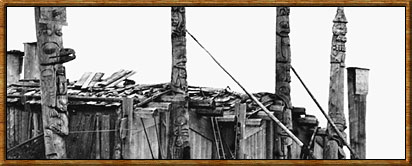 
(Page 1 of 2) |
Tanu

Tanu, which is located on Laskeek Bay, is an important Haida village whose name refers to a type of sea grass found nearby. It was often called Kloo's village (also spelled Clue or Klue), meaning "southeast (wind)," after the name of its town chief. The town was founded sometime after 1725 and abandoned in the 1880s. The last chief, Gitkun, died in Skidegate early this century.
In 1967, I recorded (but did not excavate) a mass grave at Tanu that represented the last mortuary ceremony performed about 1885, just before the remaining occupants left their village to the encroaching forest. Prompted by the missionaries to inter their dead, the people of Tanu collected all of the remains from the mortuaries and laid them in a common grave of more than fifty individuals.
George M. Dawson, who visited this village in 1878 during his work for the Canadian Geographical Survey, wrote a vivid description of a Haida house:
The village consists of perhaps twelve or fourteen of the large houses usual on the coast, & bristles with totem poles carved into Grotesque figures. Some of the houses entered through holes in the bases of the poles, but Clue's by an ordinary door. Descending some steps one is in a rectangular area depressed somewhat below the level of the ground outside, with several broad steps running round it, on which the family goods, bedding &c. placed. In the Centre a square area not boarded in which a bright fire of small logs burns, the smoke passing off through apertures in the roof above. Clue with some of his friends occupied positions on the further side of the fire from the door. Squatting on Clean mats, several women, who however kept in the background.
Dawson went on to add: "There are about 32 upright totem poles in the village of all ages, heights, & styles . . . about sixteen, including one unfinished, though evidently some time under way." He was also fortunate enough to witness the raising of a totem pole, which he describes:
There were a considerable number of strangers here at the time of our visit in July, 1878, engaged in the erection of a carved post and house for the chief. The nights are given to dancing, while sleep and gambling divided the portions of the day which were not employed in the business at hand. Cedar planks of great size, hewn out long ago in anticipation, had been towed to the spot, and were now being dragged up the beach by the united efforts of the throng, dressed for the most part in gaily coloured blankets. They harnessed themselves in clusters to the ropes, as the Egyptians are represented to have done in their pictures, shouting and ye-hooing in strange tones to encourage themselves in the work.
Dawson also took a photograph of Tanu: "Present Chief Klue with a pound of tobacco, & finding no objection take a photo of the village. Would have taken several but the rain threatening all the morning now began." The photograph is the only one that portrays Haida village life of the time as it might have been observed on a casual visit. At least a dozen people appear in the photo, including a totem pole carver at work, not to mention several dogs. Domestic enterprises are evident in clothing hung to air next to a rain barrel, and halibut fillets and other foodstuffs drying on a rack. The greatest activity occurs at the door to Chief Gitkun's house, beside a double row of food boxes covered with cedar bark mats and tied neatly with cords for a sea journey.
|